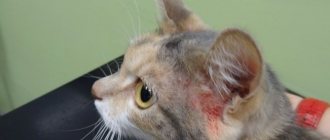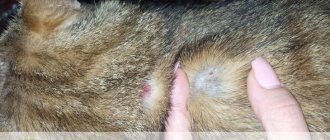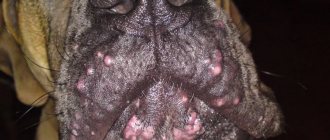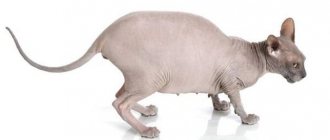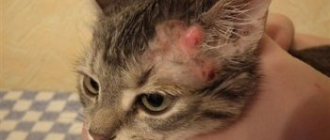Types of allergies
Allergy to environmental elements. The manifestation can be noticed in sphinxes up to 3 years old. It is very insidious because it is very difficult to define, and very little is needed to occur. Anything can cause it (mold, pollen, chemicals, etc.)
Allergy to flea bites
The Sphynx has no fur and many people believe that there is no place for fleas, but this is a deep misconception. They can be inside the ears and in the armpits. Fleas can also bite after jumping from another animal. The worst thing is that some owners do not treat him at all, because they believe that their pet does not and cannot have fleas.
Allergy to food
Food allergies in sphinxes are very difficult to determine, and the allergen is excluded from the diet. It does not develop in one day, because some allergens first accumulate in the body, and then they only begin to act. It is easier to determine allergies in animals older than 1 year. But when the allergy in Sphynx cats is repeated, a minute is enough for its reaction.
Also, in Sphynxes, allergies to food and dairy products can develop throughout the year. Most often, cats are allergic to protein found in foods. Often, owners feed their pet chicken without paying attention to other protein. Some dry food manufacturers skimp on ingredients and add a lot of untested chemicals.
Ulcers
Appear on the skin, mucous membranes and oral cavity. It has clear red borders and can sometimes be painful and itchy.
Esinophilic plaque
Manifestation of eosinophilic allergic syndrome. Appears on the stomach and inner thighs. It appears as an oval red lesion.
Esinophilic granuloma
Appears on the skin, mucous membranes and oral cavity of the sphinx. Lesions can appear on any part of the body. Yellowish-pink plaques appear.
Sphynxes are allergic to flowers
All cats love to taste our flowers, but this habit can lead not only to allergies, but to death. We all urgently need to know poisonous flowers:
Symptoms of Sphynx allergies
Photo: Allergic spots on the body of the Sphynx.
All these manifestations do not always indicate an allergy. These may be: vitamin deficiency, fungal diseases, endocrine gland disease and scabies. For example, dermatitis is more related to seasonal allergies, and fleas bite on the tail and back.
To determine the allergy, you need to take your Sphynx to the veterinarian. Skin allergy symptoms may last up to 10 weeks. The manifestation of allergies in sphinxes can be seen in the photo below.
Allergies in Sphinxes: treatment
In order to cure food allergies in Sphynx cats, you need to follow a diet. It is necessary to identify and eliminate the allergen from the diet.
Specialists take scrapings from the skin to determine the microbial microflora. But if the tests are negative, then you still need to carry out antimicrobial treatment. Then allergy tests are performed. They help to identify exactly what cats are allergic to (mites, dust, fleas, medications, household chemicals, etc.).
What to do:
What is flaking and how does it manifest itself in bald people?
Peeling is the formation of scales (squama), keratinized pieces of the epidermis.
The separation of keratinized particles of the epidermis occurs constantly and is a normal physiological process, that is, the skin is renewed. With various skin diseases, this process intensifies. Scales can be separated either in very small (pityriasis-like) pieces or in plates. Depending on the underlying disease, the skin may be swollen, hyperpigmented, or, on the contrary, thin out and become almost transparent and reddish. Peeling of the skin in Sphynx cats develops for many reasons, and often occurs when the air in the room where the cat lives is too dry. Let's look at the main causes of dry and flaky skin in cats.
- Sunburn. Since sphinxes do not have fur, nothing protects their skin. Their skin is quite sensitive to ultraviolet radiation, tans and “burns” quickly. It is advisable not to allow the cat to remain in direct sunlight for a long time.
- Allergic reaction to external irritants (flea saliva, chemicals, skincare products, etc.) Against the background of an allergic reaction, an inflammatory process develops and the separation of the epidermis increases;
- Fungal skin infections - Malassezia dermatitis, trichophytosis, microsporia. All of these diseases damage the skin, causing inflammation and peeling.
- Autoimmune diseases – pemphigus, vasculitis. Often found in Sphynx cats due to their particularly sensitive skin.
- Bacterial skin infections usually overlap with the primary disease, causing pyodermatitis, itching, and hyperkeratosis.
- Parasites. Despite the lack of hair, Sphynx cats are often affected by ticks and fleas, which significantly injure their sensitive skin.
- Ichthyosis is a hereditary disease accompanied by increased keratization and impaired desquamation of dead epithelium. It is quite rare in cats.
As we can see, flaking in Sphynx cats can be caused by a variety of factors, so it is necessary to make a diagnosis after a comprehensive examination of the cat. At home, if there are no other lesions on the skin besides peeling, you can try changing your skincare products and being more attentive to your cat’s hygiene. If there is no positive dynamics, try to make an appointment with a dermatologist. The doctors at our veterinary clinic will carefully examine your pet, perform a series of diagnostic tests to identify the cause of the flaking, and prescribe the optimal treatment.
The main diseases of the Don Sphynx
From birth, Don Sphynx kittens are predisposed to inflammatory diseases, corneal ulcers, conjunctivitis, and scleritis. As soon as the kitten opens its eyes, the animal's coordination system has not yet been formed. They can injure the eyes from various obstacles and objects. Kittens' eyes require daily examination. It is necessary to remove lint and mucus from them, and also wash them with furatsilin.
The Don Sphynx breed is the most susceptible to diseases compared to other cat breeds. The causes and diseases are very specific.
Allergy
Glycoprotein (Feld1) is the main culprit in allergies. The glycoprotein appears in the saliva of the Don Sphynx, because... the allergen cannot develop on the fur. Allergies in an animal can only appear on the skin. Cats regularly lick their skin, leaving a lot of saliva on their bodies that provokes a hyperreaction. The Don Sphynx literally emits allergens that are contained in the animal’s saliva, dander, and urine.
Be sure to find out whether the allergy is actually caused by your pet. It can be caused by house dust, food, flower dust and many others. Remember, allergies are not a reason to give up pets.
Description of diseases and defects of the Don Sphynx
A carp bite (shortened lower jaw) is a congenital disorder of the ossification of the jaw. Malocclusion occurs in all domestic animals, but is most common in the Don Sphynx. A violation is considered to be a displacement of two rows of incisors that cannot align. The violation occurs due to the arrest of the animal's growth at the moment when the symphysis in the lower jaw of the incisive bone ossifies prematurely. Sometimes such a defect is mild and does not bother the animal. Long fangs can injure the upper jaw, which quickly develops painful “pockets.” Because of such “pockets,” the cat develops gingivitis. The short lower jaw of the Sphinx is formed due to underdevelopment of the tail vertebrae, stunted growth and dwarfism. Sphynxes with this pathology are not suitable for reproduction.
Microphthalmos is abnormal development of the eye, decreased vision or blindness. With microphthalmia, the eyeball is reduced. Microphthalmos is closely associated with other eye defects: cataracts and congenital keratitis. Many kittens are born with open eyes, tumors, an orbital cyst, and an incomplete palpebral fissure. These defects are noticeable immediately after birth or after 7–10 days. Sometimes it is impossible to do without the intervention of plastic surgery. But even surgery will not completely remove these defects.
Bowing and softening of the tail spine is another common occurrence in this breed. Kittens with a bent tail are present in every second litter. Further breeding of such kittens is impossible. They are born non-viable with additional defects: underdevelopment of the intestines, weakness of the anus, shortening of the thoracic, lumbar vertebrae and lower jaw.
Nipple hyperplasia in the Don Sphynx is a hereditary phenomenon that is transmitted from the mother. After a year of life, the nipples begin to turn red, and the skin in this area thickens. The nipple increases in size, forming cysts. Therapeutic treatment is ineffective. Kittens from such a cat are often not viable and may have underdeveloped internal organs.
Diseases of a hygienic nature
- Microphthalmos. This is a congenital defect of the eyeball; it is reduced in size. As a rule, this pathology occurs due to an infection suffered during pregnancy. The pathology, as a rule, leads to decreased vision and is treated exclusively with surgery.
- Curvature of the tail. With this disease, pathology of the skeletal system is observed. As a rule, this is a congenital defect; very often kittens with such a congenital defect have underdeveloped intestines and a dwarf appearance. The reason for this anomaly is inbreeding.
Skin diseases
Don Sphynxes are susceptible to a number of skin diseases.
Acne
Acne (acne) in the Don Sphynx can appear at any age. Skin lesions are observed in both male and female cats. The disease affects the surfaces of the tail and back along the spine, neck, surface of the abdomen and muzzle. Sometimes this pathology causes pigmentation of the skin surface. Acne develops due to a hereditary predisposition. For treatment, salicylic acid and hydrogen peroxide are usually prescribed, which are applied to the keratinized areas. The following drugs are actively used: Delex-Acne gel or solution for mild forms, Zinerit for severe forms, Minocycline, Lindamycin, and others. But it’s better not to experiment, but to immediately contact a veterinarian.
Nodular cystic acne
This disease is the formation of infiltrates and cystic cavities that are filled with fluid. Merging with each other, they come out through the fistula tracts. If your pet has suffered from this disease, it may develop permanent scars. For treatment, veterinarians usually prescribe Zinerit, Clindamycin 1%. Liniment and lotion Doxycycline - Unidox.
Seasonal dermatitis
Excessive scratching of the skin may lead to secondary infections and, consequently, the formation of eczematoid areas. Dermatitis is usually treated with a single injection of Dexafort and Terramycin spray applied to the animal's skin. If the Sphynx is always at home, then the risk of contracting an infectious disease is small.
Seasonal dermatitis affects only females before or after estrus.
Ringworm or dermatophytosis
Ringworm, or dermatophytosis, is another serious threat. Infection occurs through contact with a sick animal or contaminated environment. Kittens are mainly at risk of the disease due to their weak immune system. Sick animals gradually become bald and their skin peels off.
If you think that your Don Sphynx has contracted lichen, then immediately contact your veterinarian to find out exactly what he is suffering from.
If your veterinarian has diagnosed ringworm, strictly follow all long-term treatment procedures.
Ringworm is treated with antimicrobial treatments and medications.
The only and reliable way to protect your pet from all diseases is to get vaccinated. The first vaccinations are given at 2–3 months from birth. The next vaccinations are 3-4 weeks after the first. 7–10 days before vaccination, the animal must be given an anthelmintic drug. Ringworm will not go away on its own!
Take care of your animal and regularly carry out all the necessary procedures. And remember that only a specialist can make a diagnosis!
Sphynx skin care: acne and pimples
All Sphynxes (regardless of breed) are covered with a brown, wax-like coating (sebum mixed with natural pollution), which is designed to protect the animal's skin from external influences. In some cats this plaque forms constantly and abundantly, in others it does not form at all. It is believed that the amount and regularity of plaque formation depends on properly selected food, genetic characteristics, the health of the cat and the temperature in the room (the hotter it is, the more Sphynx cats sweat).
To remove plaque, you need to regularly wipe your Sphynx with wet wipes for cats (without alcohol!) or just a terry towel moistened with warm water. Particular attention should be paid to the ears (they can be cleaned with cotton swabs or cotton swabs), fingers and the area around the eyes - plaque accumulates there more often and in greater quantities than on other parts of the body.
Sphynxes' skin often peels and cracks. To prevent this from happening, you need to humidify the air in the apartment and the animal’s skin itself. For example, a Sphynx can be lubricated with oil (baby oil for cats) or washed with a moisturizing, nourishing shampoo (products with mink oil work well). And, of course, you should not allow your pet to interact too closely with the radiator; they can not only dry out the skin, but also leave serious burns.
The formation of acne and pimples is typical for Sphynx cats. As a rule, they form on the tail, chin and belly of the animal. The reasons for their formation and treatment are the same as for all other cats. As a preventive measure, it is recommended to periodically wipe the areas where acne is most likely to appear - with micellar water, chlorhexidine or a special lotion (the latter should be washed off with warm water). Castration of the animal can also reduce the formation of acne, since hormonal surges contribute to the occurrence of skin problems.
Sphinxes, like people, sunbathe in the sun, and to do this, they just need to lie on a sunny windowsill and do not necessarily have to go outside. Tanning is harmful to cats, and staying in the sun for too long can cause sunburn. Therefore, in the summer, sphinxes need to be dressed in clothes, and even better, lubricated with children's sunscreen (45-60 units).
Bathing the Sphynx is a controversial issue. On the one hand, you need to remove plaque, which is not always and not completely washed off with wet wipes; on the other hand, frequent washing can cause increased plaque release. Vicious circle. And, apparently, each Sphynx owner must decide for himself how often to bathe his animal and whether to bathe it at all.
When bathing your Sphynx, it is recommended to use a special shampoo for Sphynxes or short-haired cats. Particularly dirty areas can be gently rubbed with a sponge or baby washcloth. After bathing the sphinx, you should pat it dry with a towel, lubricate it with oil and put it on something, so the oil will work better and the cat will not freeze.
Hairless cats may develop spots on their skin.
Owners of hairless cats do not have problems with the hair of their animals, since they simply do not have it. This makes caring for your pet much easier. There is no need to comb it very often. However, they are faced with another problem - the appearance of dark spots on the surface of the animal's body. Where do they come from? Why do they arise?
READ What to do if fur gets into your rabbit's stomach
Hello!
There can be many reasons for the symptoms you describe. Describe in detail the animal's diet, indicating the ingredients included in it. When did you perform routine deworming? When was the animal vaccinated and with what vaccine? What additional vitamin supplements do you use? This is very important diagnostic information. Please provide it as soon as possible.
Please note that Whiskas, Friskas, Meow, Felix and Kitiket foods are not recommended for feeding cats. Neither dry nor wet. These are very harmful foods that can sooner or later provoke gastrointestinal diseases and quite often lead to the death of the animal. Sausages, milk, soups, borscht and all other “things that we eat ourselves” are not suitable for feeding cats. This rule is.
Feed your animal either a high-quality commercial food: Acana, Gina, Orijen, Hills, Royal Canin, Eukanuba, Go Natural or Now Fresh. Or natural products: rice, oatmeal, buckwheat, beef, turkey, rabbit (not in the form of minced meat) and stewed vegetables (cabbage, cauliflower, carrots, beets).
The animal has allergies (due to poor nutrition) and miliary dermatitis and, apparently, a staphylococcal infection. Perhaps hypovitaminosis also has a significant impact on the manifestation of this kind of symptomatology. Treatment must be comprehensive.
Instead of water - chamomile decoction 1 tsp. per 1 liter of water – up to 7-10 days.
- White coal 1 tablet or Ataxil 10-20 ml. ext. 2 r. in the village - up to 12 days. in 60 min. before or after meals and giving medications externally.
- Nux Vomica 5 drops. for 1 tsp. water int. 3 r. in the village - up to 7-10 days.
- Mezim 1/2 tablet. ext. 2 r. in the village - up to 10 days.
- Emprobio 3-4 ml ext. 2 r. in the village in 30 minutes. before meals - up to 14 days. or Hilak 5 drops. for 10 ml of water int. 2 r. in the village - up to 7-10 days.
- Salvikal or Vitabon up to 3 months according to instructions
- Bathe the animal with TropiClean Oxy-Med Oatmeal Shampoo, removing all crusts, then once every 1-2 months.
- Treat affected areas with hydrogen peroxide 2-3 times. in d. until completely clean up to 14 days.
- Local treatment with Chlorhexidine 3 r. in the village up to 14 days
- Topically lubricate the affected areas with Methylene blue (alcohol solution) 2 r. in the village up to 12 days.
- 20 minutes after step No. 10, lubricate the affected areas with Clotrimazole or Ecodax 2 r. in the village up to 12 days.
- Suprastin 0.4 ml i.m. 2 r. in the village up to 12 days.
- Lipoton 0.5 ml pc. 2 r. in the village up to 12 days.
Inform about the cat's condition once every 3-5 days.
Additionally, your question has been submitted for general discussion in our group on the social network “VK”.
Pink spots have appeared on the Sphynx's skin, what should I do? This question is often asked by owners of Don Sphinxes, Canadian Sphinxes and Peterbalds. What are these mysterious spots?
Let us describe in more detail the appearance of these spots: pale pink, ring-shaped, with an uneven halo; inside the ring, the skin remains its normal color. They are not striking, but are noticeable only upon closer inspection. The spots do not cause any concern to the cat and the animal’s behavior does not change.
Causes of spots on the skin of the Sphinx
Speaking about the reasons for the appearance of spots on the skin of a sphinx, first of all it is worth noting that they can be different. So, the following can lead to the development of pathology:
Let's look at how rashes manifest themselves and how they are treated in one case or another.
Dermatitis
Dermatitis is a direct consequence of contact with one or another allergen and can be accompanied by the appearance on the animal’s skin:
In addition, allergic manifestations may include common skin symptoms - redness, dandruff and itching. The animal scratches itchy places, as a result of which wounds and eczema appear on its body.
Dermatitis can be managed by eliminating contact with potential allergens. The cat should be put on a hypoallergenic diet (lamb and rice), and antihistamines and steroids should be used to alleviate its condition.
Removing stains
Breeders of hairless cats should carefully follow their veterinarian's recommendations. After all, the treatment regimen is prescribed in accordance with the established type of pathology:
- allergy symptoms disappear after taking antihistamines (Metypred, Cetrin, Suprastin). If the body does not accept meat or poultry, it is recommended to switch the cat to premium food, for example, Hills or Acana. If stains appear after a walk in synthetic clothes, you just need to replace the item of clothing with items made from natural materials;
- For the treatment of skin diseases, external agents are prescribed (Sanoderm, Clotrimazole, Thermikon, Imaverol). In severe cases, antibacterial drugs are prescribed for oral administration (Ketoconazole, Griseofulvin);
- To avoid the appearance of spots on the Sphynx's skin after insect or tick bites, blood-sucking parasites should be prevented from coming into contact with the animal's body. For prevention purposes, collars, sprays, ointments, and drops are used. The effective and most popular brand in the fight against parasites is Bars;
- hormonal imbalance is corrected by sterilization and castration of the pet. If the owner does not want to deprive the sphinx of a full life, the doctor may prescribe hormonal medications, vitamins, and probiotics;
- Anti-scar ointments and creams will help get rid of scars.
Hyperpigmentation of unknown etiology will disappear if chlorhexidine is used. It is enough to wipe the problem areas with a cotton swab soaked in the solution a couple of times a day, and not a trace will remain of the stains.
Sources:
https://nutriacultivation.ru/archives/10303 https://kozhakoshek.com/pyatna-na-kozhe-u-sfinksa.html https://okoshkah.com/pyatna-na-tele-u-sfinksa.html
Sphynx skin spots photo
Vasculitis
Vasculitis of the skin is a pathology accompanied by inflammation of the vascular walls and developing against the background of:
Spots on the Sphynx's body associated with taking medications appear 7-20 days after taking the medication.
Vasculitis that begins against the background of changes in hormonal levels or stressful situations occurs in several stages. Over the course of 2-5 days, rashes appear, and then within 1-2 weeks the skin manifestations disappear.
The manifestations of the disease largely depend on the gender and color of the animal - vasculitis in sphinxes in this case can occur in the following types:
The telangiectatic type is diagnosed, as a rule, in cats involved in breeding work. The pathology is accompanied by the appearance of spots on the skin of the sphinx of a pinkish or brownish-red hue, muted in the central part and more pronounced along the outer contour (as a rule, there are dark dots along the edges of the lesions). Rashes form on the sides, back, abdomen, paws and groin (occasionally on the head and ears) and, as the disease progresses, increase in size, merge and acquire indistinct and blurry outlines. The animal does not experience any unpleasant sensations.
Livedo type is diagnosed, as a rule, in cats of creamy blue and red shades, as well as harlequin color. The onset of the disease is characterized by the appearance of a vascular network along the spine, in the area of the shoulder blades and the back of the head. After several days, bluish spots appear in place of the mesh, becoming covered with small nodules and hemorrhages as the pathology progresses. Some of the nodules necrotize over time, forming painful ulcerations. Healing occurs with the formation of blisters filled with exudate and covered with a dark crust.
The eczematoid type develops in both male and female cats, regardless of their color, and begins with the appearance of a small eczematoid spot on the hind legs or tail. The affected area swells and turns red, papules and crusts form. The animal experiences severe itching and licks the skin, injuring it and promoting secondary fungal and staphylococcal infection (in this case, the spots quickly spread upward along the limb, subsequently moving to the stomach).
The polymorphic type is manifested by rashes characteristic of the pathologies described above.
Vasculitis therapy is aimed at strengthening the immune system, preventing stressful situations and reducing the severity of skin manifestations.
Fungal infections
Fungal infections (Microsporia and Trichophytosis) are manifested by the appearance of red spots on the Sphynx's body that increase over time, covered with crusts and scales. Treatment of pathology involves the use of internal and external antifungal agents, for example, Itraconazole.
Associated symptoms of diseases
Detected stains can be removed. True, first you need to establish the cause of their occurrence. Each disease manifests itself in a special way:
- Allergy. As a result of the body's reaction to poor-quality clothing or food, a rash appears. The problem is accompanied by redness and watery eyes, apathy to what is happening around.
- Dermatitis. Infectious and fungal diseases spread quite quickly over the entire surface, spots on the Sphynx's skin flake and itch, and sometimes ulcers form.
- Parasites. At the site of an insect bite, such as a flea, the body becomes red and inflamed.
Treatment of a disease caused by an infection, fungus or allergy should be carried out under the supervision of a specialist.
Allergic reaction to hairless cats
As you know, cats are the most beautiful, graceful, and intelligent pets. Of course, they do not strive to be a person’s friend, but, nevertheless, they allow themselves to be loved, caressed and cherished. It’s impossible not to admire them! But living with an allergy to your favorite type of pet is extremely unpleasant, and even very dangerous! In this article we will tell you how and under what conditions an allergy to sphinxes occurs, and how to avoid it. After all, as you know, Sphynx cats are one of the most hypoallergenic breeds among all cats.
Approximately ten percent of people suffer from pet allergies, and the most common form of allergy disease is cat intolerance. Allergic reactions to cats occur in humans twice as often as allergic reactions to dogs. And to solve this problem, people come to the conclusion of having a hairless cat at home. But this, in the end, turns out to be a wrong decision, since allergies to hairless cats also exist. And the cause of this disease is not wool. as it turned out, but such a substance as protein. It is found in dead skin cells on your cat's body, as well as in her saliva and urine.
Many allergy sufferers are usually interested in the question of whether there is an allergy to Sphynx cats, and what are the causes of this problem. Unfortunately, absolutely all cats can cause allergic reactions in humans. And despite the fact that sphinxes have absolutely no hair, they can cause allergies more often than long-haired animals. Because hairless cats produce twice as much protein as other cats. This is due to the fact that they sweat more often. Even if you are not allergic to cats. Sphynxes can cause it in an allergic person by bringing dust from the street. mold or other allergens.
How does pregnancy and childbirth proceed?
Sphynx cats tolerate pregnancy well and give birth on their own; their instinct is excellent, which is very valuable. Kittens are born full term, grow well and develop well. Naturally, for the pregnancy to be successful, it is necessary to take care of the cat from the first days, then the birth will take place without complications.
We recommend reading: Skin Diseases of the Paw Pads in Cats With Photos
Here are some tips for preparing for childbirth
- In order for your cat to give birth to healthy kittens, you need to give birth in comfortable conditions. Therefore, as soon as the cat becomes pregnant, you need to take care of her birth place. You can prepare a cardboard box and cover it with a sheet to make it more comfortable for the kittens to be there.
- If the birth is already close, you need to prepare the necessary things that will be useful to you, this is a heating pad, it will need to be filled with warm water, a second diaper, sterile scissors. Even if your cat's pregnancy went smoothly, delivery can still be complicated, so you need to be prepared for anything.
- If you notice that your cat has begun to eat poorly and hide in inaccessible places, you should know that your cat is already in the last stage of pregnancy. Perhaps this behavior indicates the cat is having contractions. Therefore, if you notice that the animal is not behaving as usual, it is better to play it safe and try to move it into a box. But this must be done carefully and carefully so that the animal does not get scared, otherwise she will not give birth there.
Clinical picture of the disease
Symptoms of allergies to hairless cats vary widely. As the body fights the allergen, a person begins to experience the following negative reactions:
Many people still don’t believe that hairless cats can cause severe allergic reactions.,
so they are interested in whether there is an allergy to sphinxes? After all, it is believed that because sphinxes are hairless, they are less allergenic. But in fact, any cat is potentially dangerous; in any case, it can cause illness. And in this case this does not depend in any way on the breed, length of coat or shedding. A person who decides to get a pet such as a cat is still potentially exposed to diseases such as allergies. So, for people suffering from allergies, the idea of having a pet is not a good one.
If you are planning to get a Sphynx, then remember that an allergy to the Sphynx will also not be excluded.
How to reduce the risk of an allergic reaction
It is advisable to neuter a cat or female cat, since neutered cats are less allergenic.
Dermatitis is a skin disease, local inflammation and redness of the skin
in certain places of the body. Dermatitis in children is a consequence of infection, toxic exposure or allergy. Dermatitis in an infant appears in the form of rashes, crusts, and redness. Let's consider the causes of dermatitis in young children and preschoolers, the types of its manifestations and treatments.
Skin dermatitis is often called diathesis. The age of the child most susceptible to rashes is up to 3 years. At this age, signs of the disease (rash and redness on the face, around the mouth, in the groin) appear much more often than during the school period.
If an irritating substance first enters the gastrointestinal tract, then into the blood and only then onto the skin, the disease is called toxicoderma
.
Inflamed areas of the skin may appear as redness, peeling and abrasions (the mildest form of the disease), as well as rashes, pimples, blisters, blisters and wounds.
Often parents use local remedies (ointment, powder) without analyzing the cause of skin inflammation. This is not true. Treatment of the rash requires both external and internal treatment.
The blisters are unpleasant because after opening they form small wounds through which infection penetrates.
. Children often scratch the rash on their arms and elbows. So dermatitis in children is complicated by infection.





